Kalona
Just 30 kilometres (19 miles) south west of Iowa City is the town of Kalona. Amongst its earliest settlers were the Amish, who arrived in the area from 1846. Many US towns and cities are named after an early settler, famous person or a place in Europe. Kalona is an exception to this rule as it is named after a bull. The arrival of the railroad in 1879 meant that the town needed a name for its station and a Mr Myers suggested the name Kalona after a bull that he owned. The town was not incorporated until 1890. In addition to the Amish, there is also a sizeable population of Mennonites living in the area. Kalona has a population of over 2,000 people and has a burgeoning antiques, craft and local products industry.
Wahl House, Kalona Historic Village
The Wahl Victorian house was built in 1892 by Charlie Yoder to replace a stagecoach hotel that had been destroyed by fire. It was not built here but in the unincorporated village of Joetown about 9 km (5.5 miles) north west of Kalona. It is a typical example of the Homestead Houses that were built throughout the 19th century as farmhouses. In around 1950 the house was sold to Glenn Wahl, who moved it to Kalona and re-erected it on the site where it stands today. Glen Wahl donated the land for Kalona Historic Village and after his death the Historical Society acquired the house and made it part of the Historical Village. The Wahl House is filled with period furniture and antiques. Click Tab 2 to see the Living Room of the Wahl House.
Click on Minimap to navigate
Amish Quilts, Kalona Historic Village
Quilting is a common social activity for Amish and Mennonite women. Quilts are made in these communities with great attention to detail typically to mark marriages and births. Because of its Amish and Mennonite quilt makers, Kalona calls itself the ‘Quilt Capitol of Iowa’. The Quilt & Textile Museum is located in the Welcome Center of Kalona Historical Village. The museum is started with a collection begun in 2000 by Marilyn Woodin which has since been expanded. The collection includes both Amish and ‘English’ (non-Amish, as seen by the Amish) quilts.
DLU141222


To move forwards or backwards through the Iowa trail click the arrows above, or select your next destination on the Minimap.
Kalona Historic Village
Kalona Historical Village is a collection of 13 authentic buildings from around 1880 that provide an insight into life in and around Kalona during the pioneer era. The red building on the left is the 1879 Rock Island Depot. It was under threat of demolition in 1969 after the Rock Island Railroad stopped routing trains through Kalona and shut down the depot. A local group set up Kalona Historical Society and they raised the money to save the depot building, moving to its current site and restoring it. The plan to set up Kalona Historical Village sprang from the rescue of the depot. The building on the right is known as Straw College. It is a one room schoolhouse that was actually called Summit School, but it gained its nickname from the straw stuffed behind the walls to protect the occupants from the harsh Iowa winters. The village is also the location of the Iowa Mennonite Museum and Archives which has on show artefacts related to the Mennonite culture and history
Amish School, Palm Avenue
The Amish broke away from the Mennonites in 1693 under the leadership of a Swiss bishop named Jacob Amman. While the Amish and Mennonites share the same basic religious beliefs, the Amish are a much more conservative sect, emphasising humility, family, community and separation from the non-Amish world. The most conservative Amish, known as Old Order Amish still live as they would have done in the 1800s. Their houses have no electricity, phones or televisions, they travel only in horse drawn buggies and they use horses instead of tractors to farm the land. Some Amish are less conservative, for example the Beachy Amish can drive tractors provided that they have steel wheels and cars as long as they are black in colour. Separation from the non-Amish world means that Amish children are educated in their own schools. The Amish school outside Kalona was built as a public school in 1860 in nearby Middleburg. In 1870 the school building was moved to its current location. It was taken over by the Amish in 1960 and is the oldest continuing operating school in Iowa. Click Tab 2 to see an Amish horse-drawn wagon in Kalona.
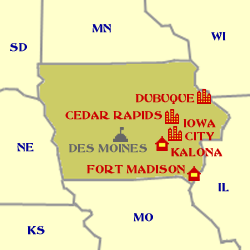

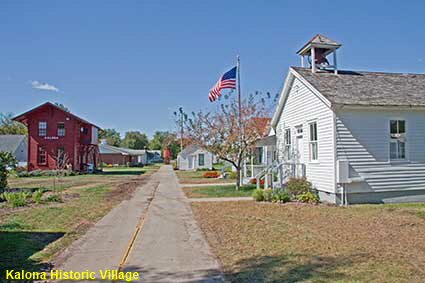
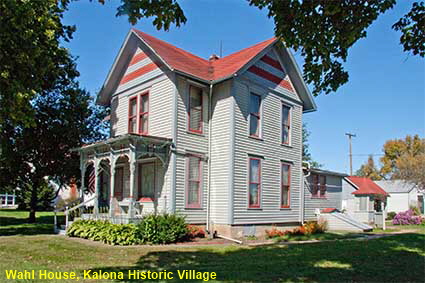
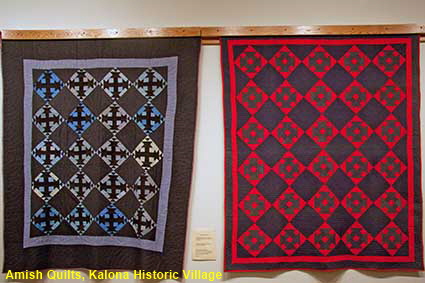
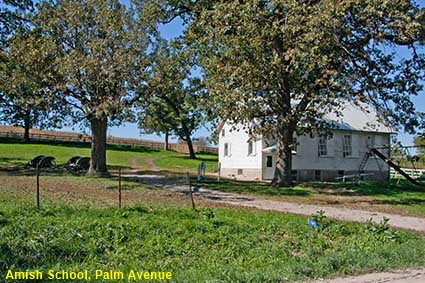
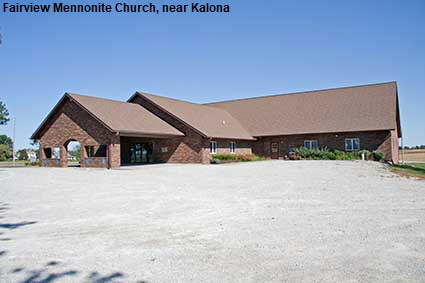
Fairview Mennonite Church, near Kalona,
The Protestant Reformation resulted in the Anabaptists splitting away from the Catholic Church and subsequently several sects formed and broke away from the Anabaptists.The Mennonites broke away from the Anabaptists because they wanted to live strictly in accordance with the sayings of Jesus. As a result, they are pacifists and they believe in living a simple life. The name Mennonite comes from Menno Simons, a Dutch priest who aligned himself with the Anabaptists in 1536. At first sight, the Conservative Mennonites look very like the Amish as their clothing has a similar old fashioned look. There are some major differences as Mennonite clothes can have zips, they drive cars and they live in modern houses with electricity and telephones. Television is not allowed in Conservative Mennonite homes. Moderate Mennonites dress just like the majority of Americans and live in houses with all modern facilities. The Fairview Church is an example of how Mennonites mix the old with the new, it is a very modern building but it is a church for Conservative Mennonites who dress in simple clothes.
© Mike Elsden 1981 - 2023
The contents of this page may not be reproduced in full or in part without permission